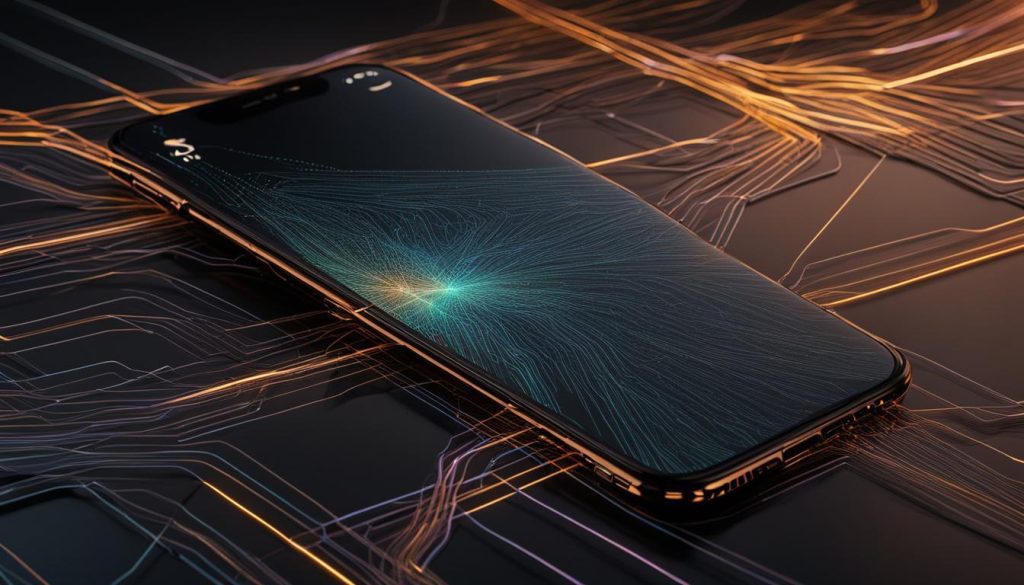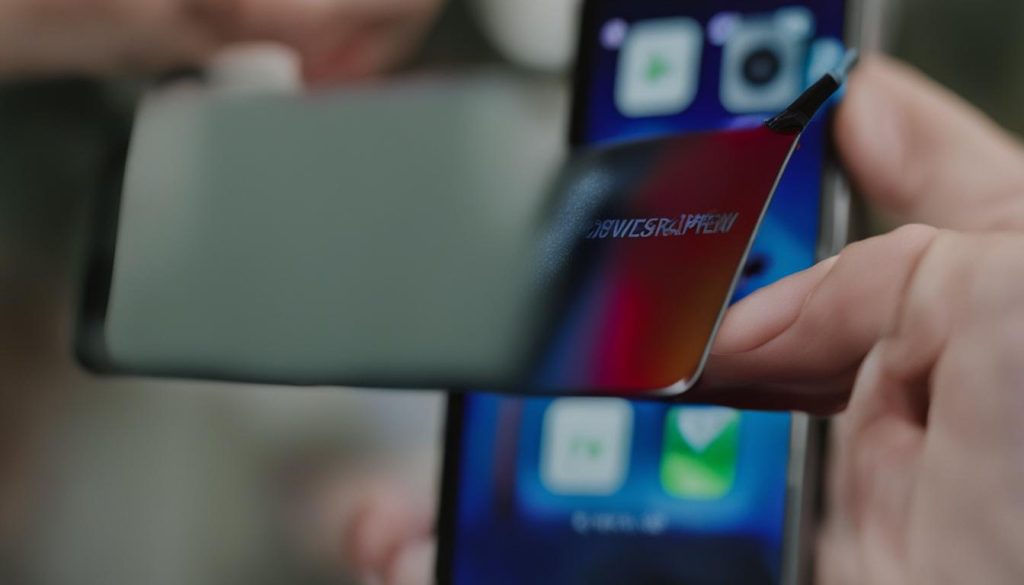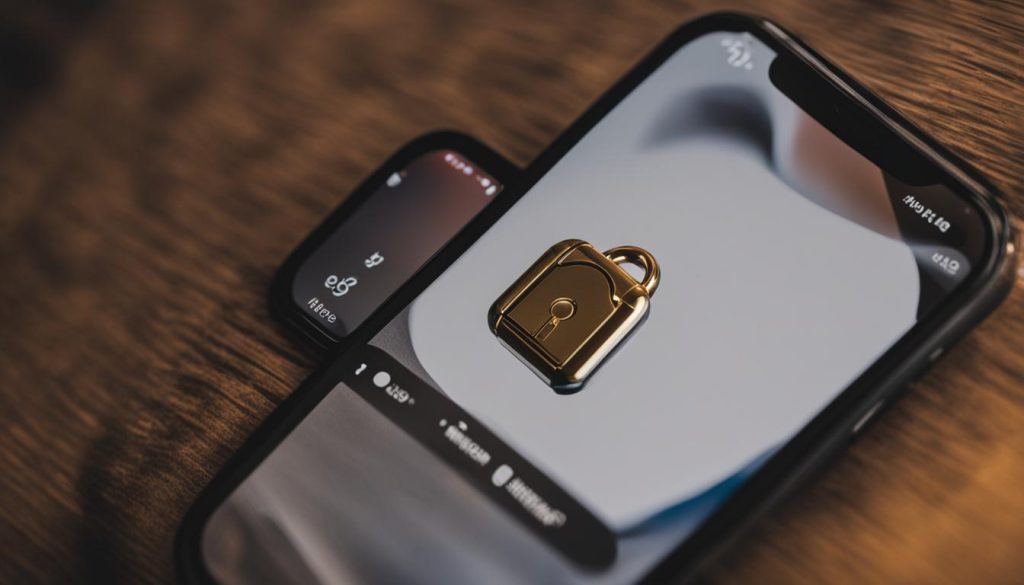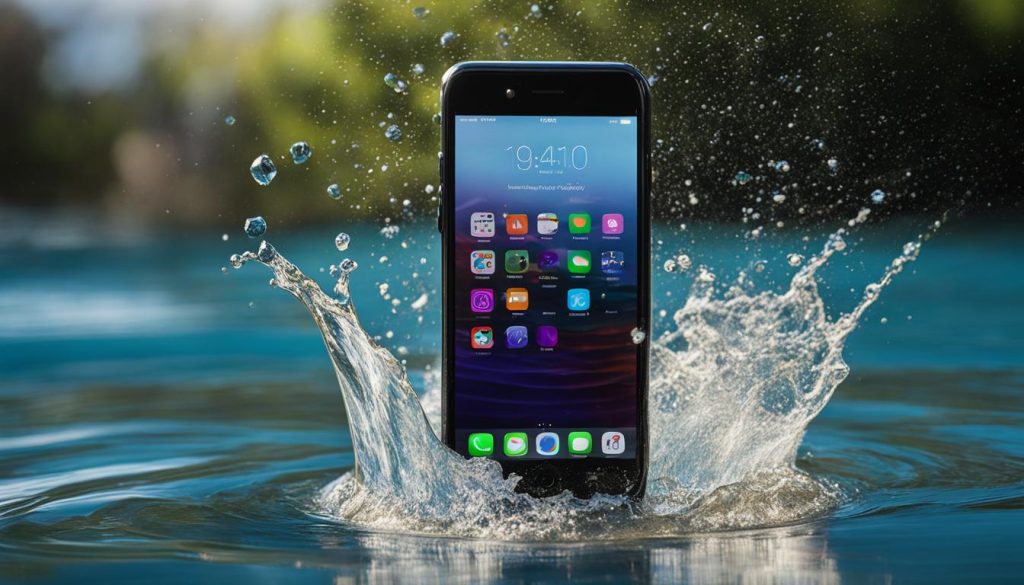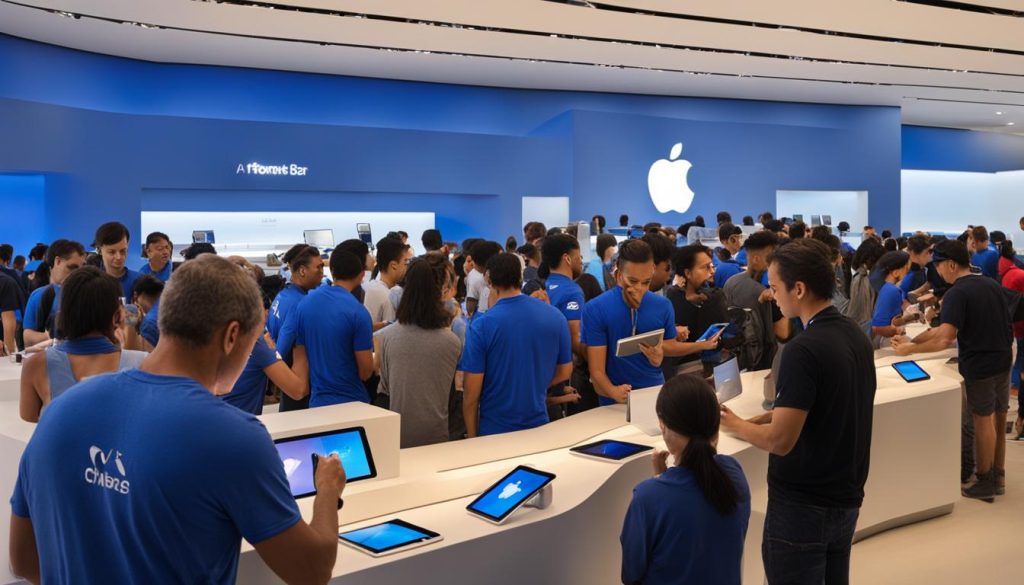As an iPhone 7 Plus user, I understand the importance of maximizing battery life. Whether you’re constantly on the go or rely heavily on your device for work, having a long-lasting battery is essential. In this article, I will share some valuable tips and tricks to help you improve your iPhone 7 Plus battery life, ensuring that you can make the most of your day without worrying about running out of power.
Key Takeaways:
- Regularly update your iPhone 7 Plus to the latest version of iOS to benefit from energy-saving technologies.
- Avoid extreme temperatures, both high and low, as they can negatively impact battery life.
- Adjust your screen brightness and utilize Wi-Fi instead of cellular data to conserve battery power.
- Enable Low Power Mode when your battery is low to extend its life.
- Monitor and manage your app usage to identify any potential battery-draining apps.
The Impact of Temperature on iPhone 7 Plus Battery Life
When it comes to the battery life of your iPhone 7 Plus, temperature plays a significant role. Extreme temperatures, particularly those above 35°C (95°F), can have a permanent detrimental effect on your battery capacity. Charging your device in high ambient temperatures can further damage the battery, so it’s important to avoid doing so. On the other hand, using your device in very cold temperatures may temporarily reduce battery life.
To ensure optimal battery performance, it is recommended to keep your iPhone within the temperature range of 16°C to 22°C (62°F to 72°F). This is the ideal temperature range for your device to function at its best. It’s important to note that MacBook and Apple Watch also have specific temperature recommendations for optimal performance.
Understanding the impact of temperature on your iPhone 7 Plus battery life can help you take better care of your device. By avoiding extreme temperatures and keeping your device within the recommended range, you can maximize battery performance and prolong its lifespan.
Table: Recommended Temperature Range for Apple Devices
| Device | Optimal Temperature Range |
|---|---|
| iPhone 7 Plus | 16°C to 22°C (62°F to 72°F) |
| MacBook | 10°C to 35°C (50°F to 95°F) |
| Apple Watch | 0°C to 35°C (32°F to 95°F) |
By following these temperature guidelines and ensuring your iPhone 7 Plus is not exposed to extreme temperatures, you can help maintain its battery health and optimize its overall performance.
Storing Your iPhone 7 Plus for Extended Periods
Properly storing your iPhone 7 Plus can help maintain its battery health and ensure optimal performance when you’re ready to use it again. Here are some key tips for storing your device for an extended period:
- Charge to around 50%: Before turning off your iPhone for storage, make sure to charge it to around 50% of its battery capacity. This helps prevent the battery from fully discharging or staying at maximum charge, which can both lead to battery damage.
- Store in a cool environment: It’s important to keep your iPhone in a cool and moisture-free environment during storage. Avoid exposing it to temperatures above 32°C (90°F) and excessive humidity, as these conditions can negatively impact the battery.
- Regularly charge every six months: If you plan to store your iPhone for more than six months, it’s recommended to charge it to around 50% every six months. This helps prevent the battery from deteriorating due to prolonged inactivity.
- Charge before use: When removing your iPhone from long-term storage, it may be in a low-battery state. Before using it, make sure to charge it for at least 20 minutes to ensure sufficient power for operation.
By following these storage tips, you can help prolong the battery life of your iPhone 7 Plus and ensure it’s ready for use whenever you need it. Remember to keep your device in a cool environment, charge it to around 50%, and regularly check its battery status to maintain optimal performance.
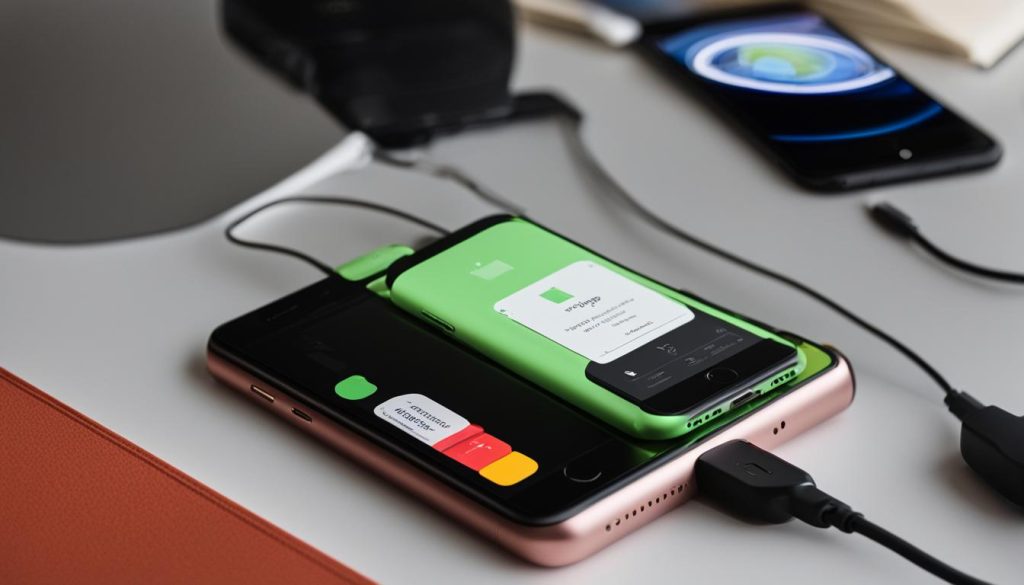

Related Article: How to Maximize iPhone 7 Plus Battery Life
If you’re interested in learning more about how to extend the battery life of your iPhone 7 Plus, check out our article on “Maximizing My Day: How can I Improve my iPhone 7 Plus Battery Life?” In this comprehensive guide, you’ll find tips and tricks to optimize your iPhone’s battery performance, including adjusting screen brightness, managing app usage, and using Low Power Mode. Don’t miss out on these valuable insights to make the most of your iPhone 7 Plus!
Adjusting Screen Brightness and Using Wi-Fi
When it comes to maximizing your iPhone 7 Plus battery life, adjusting screen brightness and utilizing Wi-Fi instead of cellular data are two key strategies that can make a significant difference. By optimizing these settings, you can extend the time between charges and ensure that your device stays powered up when you need it most.
One effective way to conserve battery life is by adjusting the screen brightness. Dimming the screen or enabling Auto-Brightness can help reduce power consumption. To adjust the brightness manually, open Control Centre and drag the Brightness slider to the bottom. If you prefer automatic adjustments, go to Settings > General > Accessibility > Display Accommodations and set Auto-Brightness to On.
Another tip to save battery is to use Wi-Fi whenever possible instead of relying on cellular data. Wi-Fi consumes less power compared to cellular data when accessing data, so it’s advisable to keep Wi-Fi enabled at all times. Not only will this prolong your battery life, but it may also provide a faster and more stable internet connection.
| Screen Brightness | Wi-Fi vs. Cellular Data |
|---|---|
| Adjust screen brightness to conserve power | Use Wi-Fi whenever possible to save battery |
| Dim the screen or enable Auto-Brightness | Keep Wi-Fi enabled for faster, more efficient data usage |
| Go to Control Centre or Settings to adjust brightness | Access Wi-Fi settings in the Settings app |
By implementing these simple adjustments to your iPhone 7 Plus settings, you can optimize your battery usage and enjoy longer periods of uninterrupted usage.
Using Low Power Mode on iPhone 7 Plus
One of the most effective ways to optimize battery life on the iPhone 7 Plus is by utilizing the Low Power Mode feature. When your battery level reaches 20%, the device prompts you to activate Low Power Mode. However, you can also enable it manually by going to Settings > Battery.
Once Low Power Mode is activated, it automatically reduces display brightness, optimizes device performance, and disables certain background activities like Mail syncing and AirDrop. Although some functions are limited, essential features such as phone calls, email, and internet access are still available. This feature can significantly extend the battery life of your iPhone 7 Plus, allowing you to use it for a longer period when you are running low on power.
When your device is fully charged, Low Power Mode automatically switches off, ensuring that you can enjoy the full performance and functionality of your iPhone 7 Plus. It is an excellent tool in your battery-saving arsenal and can make a noticeable difference in extending the overall lifespan of your battery. By using Low Power Mode strategically, you can maximize the time you spend using your device without worrying about running out of battery power.
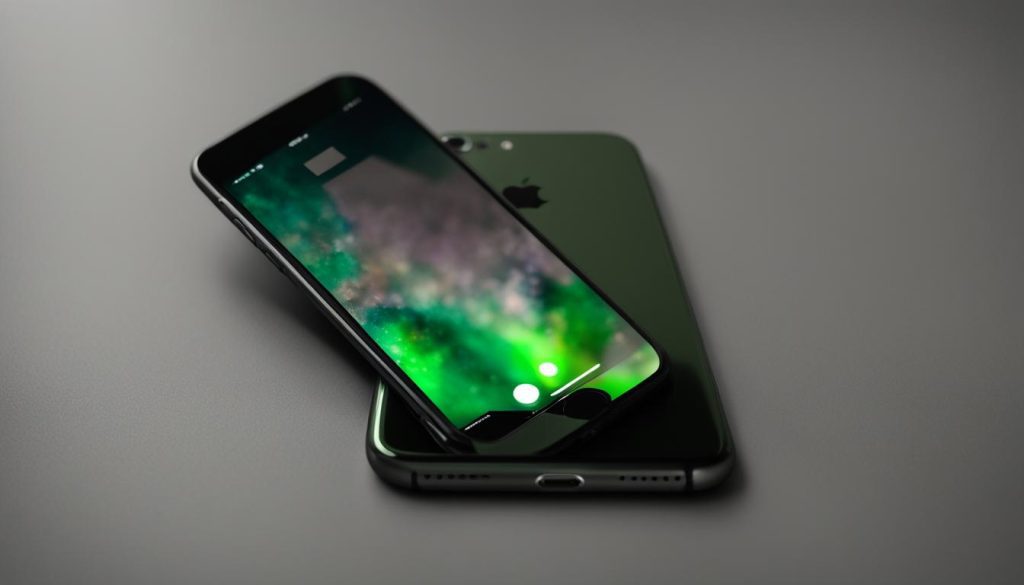

Managing App Usage to Improve Battery Life
When it comes to optimizing the battery life of your iPhone 7 Plus, managing app usage is crucial. Some apps can consume significant amounts of battery power even when running in the background, draining your device’s battery life. To mitigate this issue, it’s important to monitor and control the background activity of these apps.
To reduce background activity, go to Settings > General > Background App Refresh. Here, you can select whether you want apps to refresh in the background using Wi-Fi, Wi-Fi & Mobile Data, or turn the feature off completely. By restricting background app refresh to Wi-Fi only or disabling it altogether, you can extend your battery life and ensure that apps are not constantly using resources when you’re not actively using them.
In addition to managing background app refresh, another way to optimize app usage is to adjust the settings for email fetching. By going to Settings > Accounts & Passwords > Fetch New Data, you can choose to manually fetch email data or adjust the fetch interval to reduce the frequency of data fetching. This can help conserve battery power by minimizing the amount of data transfer happening in the background.
Location services can also have a significant impact on battery life. Many apps use location services to provide location-based features and services, but constantly tracking your location can drain your battery. To optimize battery life, visit Settings > Privacy > Location Services to review the apps that have access to your location. Disable location services for any unnecessary apps to reduce battery drain caused by constant GPS tracking.
By managing app usage and optimizing background activity, email fetching, and location services, you can improve the battery life of your iPhone 7 Plus. It’s important to strike a balance between the functionality of your apps and the impact they have on battery life. With these tips, you can enjoy longer-lasting battery performance on your device.
Performance Management and Battery Ageing
As an iPhone 7 Plus user, I’ve noticed that over time, the performance and battery life of my device have gradually declined. This is a common occurrence with rechargeable lithium-ion batteries, which are known to age and lose capacity over time. Apple has implemented performance management features on older iPhone models, including the iPhone 7 Plus, to prevent unexpected shutdowns and ensure a consistent user experience.
When a battery ages or reaches a low state of charge, the iPhone’s performance management system dynamically adjusts the device’s performance to prevent unexpected shutdowns. This may result in longer app launch times, lower frame rates, backlight dimming, and gradual frame rate reductions. However, it’s important to note that these performance management measures are less noticeable on newer iPhone models due to their advanced hardware and software design.
In order to optimize the performance of an older iPhone like the iPhone 7 Plus, it’s recommended to keep the device updated with the latest iOS version. These updates often include energy-saving technologies that can help improve battery life and overall performance. Additionally, regularly monitoring the battery health of your device and considering battery replacement if necessary can also contribute to better performance.
Understanding Performance Management
Performance management on older iPhones is designed to prevent unexpected shutdowns caused by chemically aged or low charge state batteries. By dynamically adjusting the device’s performance, the system ensures that the iPhone remains functional even with a degraded battery. While it may result in a slightly slower performance, it’s a necessary measure to prevent interruptions and maintain a stable user experience.
It’s worth noting that performance management features can be enabled or disabled depending on the battery’s health. The iOS software provides information on the maximum battery capacity and recommends battery replacement if necessary. This information can be accessed in Settings > Battery > Battery Health & Charging.
Overall, understanding the impact of battery ageing and the performance management measures implemented by Apple can help iPhone 7 Plus users optimize their device’s performance and battery life. By staying updated with the latest software, monitoring battery health, and considering battery replacement when needed, users can ensure a smoother and more efficient experience with their iPhones.
| Performance Management on Older iPhones | Battery Ageing |
|---|---|
| • Dynamically adjusts system performance | • Rechargeable lithium-ion batteries age over time |
| • Prevents unexpected shutdowns | • Capacity and performance decline |
| • Longer app launch times | • Impact on overall iPhone performance |
| • Lower frame rates | • Gradual reduction in battery life |
| • Backlight dimming |
Battery Health and Battery Replacement
Maintaining the battery health of your iPhone 7 Plus is crucial for optimizing its lifespan and performance. It’s important to monitor the battery health regularly and take appropriate actions when necessary. iOS 11.3 and later versions provide valuable information on the maximum battery capacity and recommend battery replacement if needed. To access this information, go to Settings, then Battery, and click on Battery Health & Charging. By keeping an eye on the battery health, you can ensure that your iPhone 7 Plus operates efficiently and lasts longer.
If your iPhone 7 Plus battery is significantly degraded and you experience performance issues, replacing the battery can be a viable solution. A battery replacement can help improve the overall performance and extend the battery life of your device. It is recommended to have the battery replacement performed by an authorized service provider or an Apple Store to ensure the quality and compatibility of the replacement battery. Regularly optimizing the battery lifespan through proper maintenance and considering a battery replacement when necessary can greatly enhance your iPhone 7 Plus user experience.
It’s worth noting that optimizing battery lifespan is not only about hardware but also about software. By keeping your iPhone 7 Plus updated with the latest iOS version, you can benefit from the energy-saving technologies and optimizations that Apple continuously introduces. These updates often include improvements to battery life and performance, so it’s essential to stay up to date. Taking care of your iPhone 7 Plus battery health and considering a battery replacement when needed are key steps in maximizing the longevity of your device and ensuring a smooth user experience.
Protecting Your iPhone 7 Plus from Extreme Temperatures
Temperature can have a significant impact on the battery life and overall performance of your iPhone 7 Plus. It’s important to take proper precautions to prevent overheating and avoid exposing your device to extreme temperatures. Avoid leaving your iPhone in direct sunlight or in a hot car, as this can lead to permanent battery damage. To further protect your device, it is also recommended to remove any protective cases that can trap heat during charging. By following these simple steps, you can help ensure that your iPhone 7 Plus remains safe and operates optimally.
One important point to note is that using processor-intensive apps while charging can lead to overheating. It’s best to avoid such activities during the charging process to prevent any potential damage to your device. Additionally, it’s always a good idea to keep an eye on your iPhone’s temperature and take breaks from using it if it starts to feel warm to the touch.
Apple has implemented safeguards to prevent overheating, but it’s always best to be proactive in protecting your device. By following these guidelines, you can help preserve the battery life and overall longevity of your iPhone 7 Plus.
Protecting Your iPhone 7 Plus: Tips to Prevent Overheating
- Avoid leaving your iPhone in direct sunlight or in a hot car.
- Remove any protective cases that can trap heat during charging.
- Avoid using processor-intensive apps while charging to prevent overheating.
- Take breaks from using your iPhone if it starts to feel warm to the touch.
By following these simple tips, you can help ensure that your iPhone 7 Plus remains protected from extreme temperatures and operates optimally.
Long-Term Storage Recommendations for iPhone 7 Plus
When it comes to storing your iPhone 7 Plus for an extended period, proper battery maintenance is crucial for preserving its overall health and performance. By following these recommendations, you can ensure that your device remains in optimal condition even during long periods of storage.
Preparing Your iPhone for Storage
Before putting your iPhone 7 Plus away, it’s essential to prepare it properly. Start by charging your device to around 50% battery level. This helps avoid storing the battery in a fully discharged state, which can damage its overall capacity. Once your device reaches the desired battery level, power it off.
Next, find a cool and moisture-free environment for storage. Exposing your iPhone to high temperatures or excessive humidity can negatively impact its battery and other internal components. Aim for temperatures below 32°C (90°F) to ensure ideal conditions for your device.
Battery Maintenance During Storage
If you plan to store your iPhone 7 Plus for more than six months, it’s important to periodically charge the battery. Every six months, turn on your device and charge it to around 50% battery level. This helps prevent the battery from deteriorating during extended storage periods. Once your device has reached the desired battery level, you can safely power it off again.
When you’re ready to use your iPhone after storage, keep in mind that it may be in a low-battery state. Before turning it on, give it a quick 20-minute charge to ensure an adequate battery level for normal usage.
By following these guidelines for long-term storage, you can protect the battery health and performance of your iPhone 7 Plus. Taking care of your device during periods of non-usage ensures that it will be ready to perform optimally when you need it.
| Long-Term Storage Recommendations for iPhone 7 Plus |
|---|
|
Conclusion
After exploring various aspects of iPhone 7 Plus battery life, I have discovered several tips and tricks to maximize its performance. By taking care of battery health, managing app usage, adjusting screen brightness, utilizing Wi-Fi, enabling Low Power Mode, and avoiding extreme temperatures, you can significantly extend the battery life of your device.
It is essential to prioritize battery health by keeping your iPhone 7 Plus updated with the latest iOS version. Apple’s software updates often include energy-saving technologies that optimize battery performance. Additionally, monitoring and managing app usage can help identify battery-draining apps and reduce background activity.
Adjusting screen brightness and using Wi-Fi instead of cellular data are simple yet effective ways to conserve battery power. Lowering screen brightness or enabling Auto-Brightness can significantly reduce power consumption. Wi-Fi consumes less power compared to cellular data, so keeping Wi-Fi enabled whenever possible is advisable.
Lastly, enabling Low Power Mode when your battery is low can extend its life by reducing display brightness and disabling certain background activities. By implementing these tips and understanding battery aging and performance management, you can maximize the battery life of your iPhone 7 Plus and enjoy longer usage without worrying about frequent charging.
FAQ
How can I improve my iPhone 7 Plus battery life?
To improve your iPhone 7 Plus battery life, make sure it is running the latest version of iOS and enable Low Power Mode when your battery is low. Adjust screen brightness, use Wi-Fi instead of cellular data, and monitor app usage to identify any potential battery-draining apps. Keep your device updated with the latest iOS version and avoid extreme temperatures.
What is the impact of temperature on iPhone 7 Plus battery life?
Extreme temperatures, particularly those higher than 35°C (95°F), can permanently damage battery capacity. Charging your device in high ambient temperatures can further damage the battery. Using your device in very cold temperatures may temporarily decrease battery life. It’s important to keep your iPhone within the optimal temperature range of 16°C to 22°C (62°F to 72°F) for maximum battery performance.
How should I store my iPhone 7 Plus for extended periods?
When storing your iPhone 7 Plus long-term, charge it to around 50% before turning it off. Storing a fully discharged battery or keeping it fully charged can lead to battery damage and shorter battery life. Store your iPhone in a cool and moisture-free environment, with temperatures below 32°C (90°F). If you plan to store your device for over six months, charge it to 50% every six months to prevent battery deterioration.
How can adjusting screen brightness and using Wi-Fi help conserve iPhone 7 Plus battery life?
Dimming the screen or using Auto-Brightness can reduce power consumption. Wi-Fi uses less power compared to cellular data when accessing data, so it’s advisable to keep Wi-Fi enabled. To adjust screen brightness, open Control Centre and drag the Brightness slider to the bottom. To enable Auto-Brightness, go to Settings > General > Accessibility > Display Accommodations and set Auto-Brightness to On.
What is Low Power Mode and how can it help extend my iPhone 7 Plus battery life?
Low Power Mode is a feature that reduces display brightness, optimizes device performance, and disables certain background activities when your battery is low. It can be enabled manually when needed or automatically when your battery level reaches 20%. Key functions like phone calls, email, and internet access are still available in Low Power Mode.
How can I manage app usage to improve my iPhone 7 Plus battery life?
Some apps may consume significant battery power even when running in the background. To reduce background activity, you can adjust the Background App Refresh settings and manually fetch email data. You can also disable location services for unnecessary apps. These measures can help optimize battery life by reducing unnecessary app usage.
What is performance management and how does it relate to iPhone 7 Plus battery ageing?
As rechargeable lithium-ion batteries age, their capacity and performance decline. iOS includes performance management features on iPhone 6 and later models to dynamically adjust system performance and prevent unexpected shutdowns when the battery is chemically aged or experiencing a low state of charge. This can result in longer app launch times and lower frame rates on older iPhones.
How does battery health affect my iPhone 7 Plus performance?
iOS 11.3 and later versions provide information on maximum battery capacity and recommend battery replacement if necessary. Battery health can impact overall iPhone performance, and if your battery is significantly degraded, replacing it can help improve iPhone 7 Plus performance and battery life.
How can I protect my iPhone 7 Plus from extreme temperatures?
Extreme temperatures, especially temperatures higher than 35°C (95°F), can adversely affect iPhone 7 Plus battery life and overall performance. Avoid exposing your device to high temperatures and do not leave it in direct sunlight or in a hot car. Removing protective cases that can trap heat during charging is recommended. Avoid using processor-intensive apps while charging to prevent overheating.
What are the recommended storage tips for my iPhone 7 Plus?
When storing your iPhone 7 Plus for an extended period, charge it to around 50% before turning it off. Store it in a cool and moisture-free environment with temperatures below 32°C (90°F). Every six months, turn on your device and charge it to 50%. If your iPhone has been stored for a long time, it may be in a low-battery state and require a 20-minute charge before turning on.

